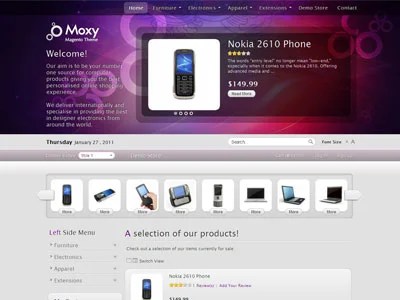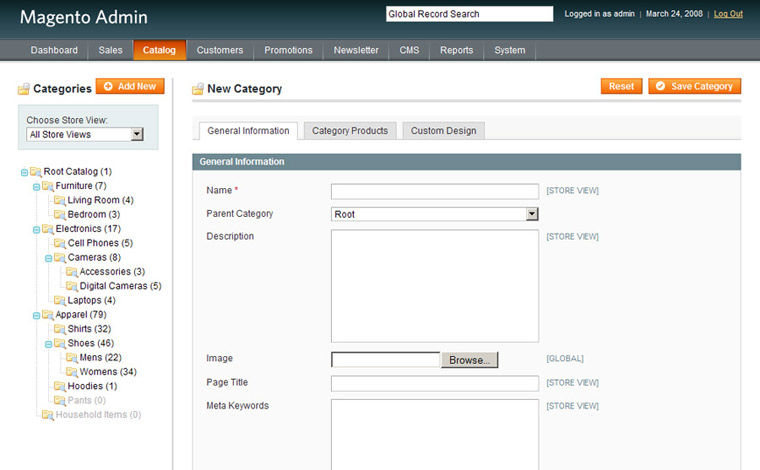Magento - Magneto Ecommerce

Magento is an open-source e-commerce platform written in PHP. The software was originally developed by Varien Inc., a US private company headquartered in Culver City, California, with assistance from volunteers.
Varien published the first general-availability release of the software on March 31, 2008. Roy Rubin, former CEO of Varien, later sold a substantial share of the company to eBay, which eventually completely acquired and then spun off the company.
According to the research conducted by AheadWorks in May 2015, Magento's market share among the 30 most popular e-commerce platforms is about 29.8%.
On November 17, 2015, Magento 2.0 was released, with an aim to provide new ways to heighten user engagement, smooth navigation, conversion rates and overall revenue generation. It has well-organized business user tools speed up build up time and enhances productivity. Table locking issues have purportedly been considerably reduced, Improved Page Caching and also allows in streamlining Guest checkout process for existing users, Enterprise-grade scalability, inbuilt rich snippets for Structured Data, new file structure with easy customization, CSS Preprocessing using LESS & CSS URL resolver, improved performance and better code base are some of the touted benefits of newer Magento version.
Magento employs the MySQL/MariaDB relational database management system, the PHP programming language, and elements of the Zend Framework. It applies the conventions of object-oriented programming and modelâ€"viewâ€"controller architecture. Magento also uses the entityâ€"attributeâ€"value model to store data. On top of that, Magento 2 introduced the Model-View-ViewModel pattern to its front-end code using the JavaScript library Knockout.js.
 History
History

Magento officially started development in early 2007. Seven months later, on August 31, 2007, the first public beta version was released.
Varien, the company owning Magento, formerly worked with osCommerce. It had originally planned to fork osCommerce but later decided to rewrite it as Magento.
In February 2011, eBay announced it had made an investment in Magento in 2010, worth a 49% ownership share of the company.
On June 6, 2011, eBay announced that it would be acquiring the rest of Magento, which would join its new X.Commerce initiative. Magento's CEO and co-founder Roy Rubin wrote on the Magento blog that "Magento will continue to operate out of Los Angeles, with Yoav Kutner and me as its leaders.".
Yoav Kutner left Magento in April 2012 citing the vision for Magento having changed since the time of acquisition due to high level staff changes.
As a result of the breakup of eBay following Carl Icahn's raid, Magento was spun out as an independent company by the new owner Permira private equity fund on November 3, 2015.
 Overview
Overview

Magento is the provider of three distinct platforms, Magento Community Edition, Magento Enterprise Edition and Magento Enterprise Cloud Edition. There were also two former platforms, Magento Professional Edition and Magento Go. Today, some of their largest users are Burger King, Nestle, Murad, BevMo, and Coca-Cola.
Magento Community Edition
Magento Community Edition is an open-source eCommerce platform. Developers can implement the core files and extend its functionality by adding new plug-in modules provided by other developers. Since the first public beta version was released in 2007, Community Edition has been developed and customized in order to provide a basic eCommerce platform.
The current release and each of the previous historical release versions of the 1.X and 2.X version branches of Magento Community Edition are available on the Magento Commerce, Inc. website for download as singe-file downloads Development of the 2.X version branch of Magento CE is coordinated publicly on GitHub.
The latest actively supported versions of Magento Community Edition are CE 1.9.3 and 2.1.2.
Magento Enterprise Edition
Magento Enterprise Edition is derived from the Magento Community Edition and has the same core files. Unlike Community Edition, this is not free, but has more features and functionality. This edition is designed for large businesses that require technical support with installation, usage, configuration, and troubleshooting. Although Magento Enterprise has annual maintenance fees, neither Community nor Enterprise Editions include hosting. The Magento team develops Enterprise Edition by cooperating with users and third parties. Development on the 2.X branch of Magento EE is coordinated publicly on GitHub.
The latest actively supported versions of Magento Enterprise Edition are EE 1.14.2.4 and EE 2.0.4 released on March 31, 2016.
Magento Go
Magento Go was a cloud-based eCommerce solution that included web hosting by Magento Inc. It was launched in February 2011 to support small businesses by providing an option that did not require software installation. Magento Go was the least customizable platform, though it still had built-in modules and could have Magento extensions enabled for more functionality. On July 1, 2014, Magento Inc. announced that they would be shutting down the Magento Go platform on February 1, 2015.
Magento 2
Magento 2 has many new and improved features, and its architecture is quite different from all the previous versions. Magento 2 was announced in 2010. It was planned for release in 2011, and its merchant beta version was released in July 2015. Since then Magento 1 and Magento 2 have existed simultaneously.
 Features
Features

Magento supports a Web template system which generates multiple similar-looking pages and customizes the theme.
Magento provides a basic theme which sets up an eCommerce website. The theme is designed for customizing all pages by adding or editing the PHP, HTML and CSS. Magento users may install themes which change the display of the website or its functionality. Without loss of content or layout of pages, themes are interchangeable with Magento installations. Themes are installed by uploading theme folders via FTP or SSH and applying them using the backend admin system.
Magento developers have created Magento plugins that extend its basic built-in functionality. Magento users can install modules by downloading them, and uploading them to their server, or applying a module's Extension Key through Magento Connect Manager.
Magento allows users to integrate several different domain names into one control panel and manage more than one storefront at a time from a single admin panel.
 Security concerns
Security concerns

In 2015 it was reported that outdated or unpatched Magento web stores are susceptible to Cross-site scripting attack, which allow attackers to perform online skimming to steal user credit card information. According to a security expert, more than 4000 Magento web stores were vulnerable to such attack in October 2016.
 "Imagine eCommerce" conference
"Imagine eCommerce" conference

"Imagine eCommerce" is the annual Magento eCommerce conference that has run since 2011. The first event was held in February 2011 in Los Angeles with more than 600 Magento merchants, partners, and developers. The goals of the “Imagine eCommerce†are sharing ecommerce ideas and providing networking opportunity sessions.
 Certification
Certification

There are four different Magento certifications. Three of them aim to prove developers' competency in implementing modules; one (Certified Solution Specialist) targets business users (consultants, analysts, project managers). Magento Front End Developer Certification is mainly focused on improving the user interface (UI) of built-in applications. This certification is related with templates, layouts, Javascript, and CSS. Magento Developer certification is geared toward back end developers who implement the core modules. The Plus certification tests deep understanding of Magento Enterprise modules and the entire architecture.


0 komentar: